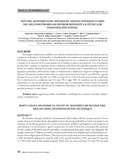Estudio anatómico del sistema de conductos radiculares del segundo premola inferior, mediante la Técnica de Diafanización Dental

Voir/
Date
2015-09-16Auteur
Palabras Clave
Segundo premolar mandibular, Morfología de conducto radicular, Diafanización, EndododonciaMandibular second premolar root canal morphology, Diaphanization, Endododoncia
Metadatos
Afficher la notice complèteRésumé
La terapia endodóntica establece una relación fundamental con la anatomía dentaria de los
conductos radiculares, al limpiarlos y desinfectarlos adecuadamente asegura la salud periapical
del diente y preserva su función. Omitir la preparación de un conducto es sinónimo de fracaso
y sucede en la mayoría de los casos porque no se localiza o ignora su presencia. Con el propósito
de describir y analizar la anatomía de los conductos radiculares del segundo premolar inferior, se
diseño un estudio descriptivo de tipo transeccional, la muestra estuvo constituida por 70 dientes
segundos premolares inferiores los cuales se diafanizaron y clasificaron según la configuración de
Vertucci. El tipo de conducto observado con mayor frecuencia fue el tipo I con el 88.6%, seguido
del tipo II en un 4,3%, tipo III con 2,9% y el tipo IV en 1,4% del total de la muestra analizada.
No se observaron los conductos tipo VI, tipo VII ni tipo VIII. Se concluye que las variaciones
anatómicas en este diente pueden estar presentes, que es importante conocer todos los detalles
y estructuras anatómicas del sistema de conductos radiculares y las diferentes variaciones que se
pueden presentar en este diente.
Información Adicional
| Otros Títulos | Root canals anatomical study of mandibular second premolar using diaphanization technique |
| Correo Electrónico | ita0302@hotmail.com |
| ISSN | 1856-3201 |
| Resumen en otro Idioma | Endodontic therapy establishs a fundamental relationship with the dental anatomy of root canals, clean and disinfect them adequately ensures the periapical health of tooth and preserves its function. Omit the preparation of a canal is synonymous of failure and happens in the majority of cases because it is not located or ignore its presence. In order to describe and analyze the anatomy of root canals of the lower second premolar, a transectional descriptive study was designed, the sample consisted of 70 lower premolars seconds teeth which were diaphanized and classified according to the configuration of Vertucci. The type of root canal observed most frequently was the type I with the 88.6%, followed by type IV with 4.3%, type II and III in 2.9%, and type IV observed in 1.4% of the total of the sample analyzed. There were no root canal type VI, type VII and type VIII. It is concluded that the anatomical variations in this tooth may be present, it is important to know all the details and anatomical structures of the system of canals and the different variations that may occur in this tooth. |
| Colación | 12-16 |
| Periodicidad | semestral |
| Publicación Electrónica | Revista Odontológica de Los Andes |
| Sección | Revista Odontológica de Los Andes: Trabajos de Investigación |





